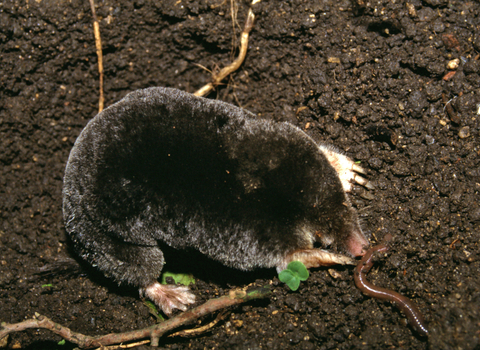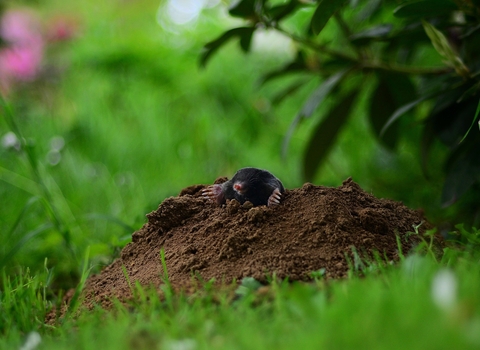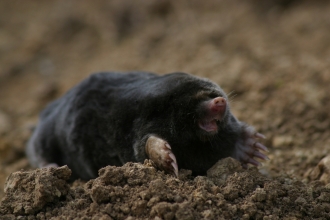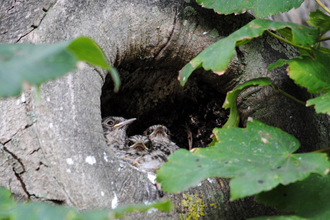
Mole eating a worm © Judi Stretton
European Mole
(Talpa europaea)
The only member of the genus Talpa in the British Isles, the mole has some fascinating common names, including 'Mouldiwarp' (literally ’earth thrower’) and 'umpty-tumpt'. In welsh, it is known as ‘twrch daear’ which means ‘earth hog’.
The mole’s short, black, velvety fur and broad, spade-like forelimbs make it instantly recognisable. Although it has no obvious ears and minute eyes, it is neither deaf nor blind. Moles are usually between 11 & 16cm long, with a short tail and weigh between 70 & 130g; males are generally larger.
In the UK, the European Mole is found throughout mainland Britain, but is absent from Ireland and the majority of the small islands. It is a highly adaptable species and can thrive at elevations up to 1000m, wherever the soil is well-drained and deep enough for tunnelling; they are most abundant in permanent pasture and deciduous woodland.
Being an insectivore a mole’s diet entirely consists of invertebrates, usually collected from their tunnels, especially earthworms and insect larvae. This includes pest species such as leatherjackets, cockchafers and carrot flies; they will also eat slugs if they come across them.
Adult moles are active day and night, alternating 3-4 hour bursts of activity with similar periods of rest; mature males may leave their nests for days at a time, sleeping in the tunnel system. Lactating females return to their nests 4 to 6 times in 24 hours to feed their 3-4 young, which are born in the spring. At birth, moles are naked and weigh as little as 3.5g. By 5-6 weeks of age they disperse above ground to establish their own territories; it is at this time that they are most vulnerable to predation by birds of prey, small carnivores (such stoats & weasels), foxes and cats.

Mole emerging from molehill; image by Ralf Siebeck from Pixabay
Molehills
Moles spend almost their entire lives in tunnels that they dig themselves, which are found at depths varying from immediately below the surface to 70cm or more. Loose soil is pushed up a shaft to the surface, forming a molehill. The main purpose of the sometimes vast tunnel system is to create a giant underground trap for invertebrates, so once a mole has set up a territory, it does not need to dig many more new tunnels. The exception to this is when they are searching for the opposite sex, usually between March and May; they are territorial and so will not share their tunnel system with another mole.
This means that unless the resident mole has to repair collapsed tunnels or extend them to compensate for flooding, there are generally two peaks of molehill formation; during the springtime search for mates and whilst the young are dispersing in the autumn. Once a mole has created a series of tunnels, there is very little visible activity at the surface.
Relations with man
Moles were once highly prized for their fur, which can lay in any direction and is waterproof. By the turn of the 20th Century more than 1 million skins were being sold each year in London, with 12 million exported to the US!
Now moles are generally considered an agricultural pest species. Contamination of the grass crop by soil may lead to poor quality silage and there is also a risk of damage to machinery and stock health. Mole runs may disturb roots and adversely affect plant growth and molehills can also degrade pasture by providing ideal seed beds for vigorous weed species. In gardens and amenity areas, molehills and tunnels can be a nuisance.
Control
The use of strychnine to kill moles was banned in August 2006, due to the risk of killing non-target species which also feed on earthworms. A 2007 study by WildCRU found that the most popular method of mole control was kill-trapping. The results also suggested that more control may occur than is justified, either economically or potentially ethically. Control efforts peaked in spring, a time at which WildCRU's previous research showed breeding males were more likely to be caught; where control is necessary, it could therefore be more effectively targeted for population control. The most effective time to control mole numbers is from October to April, when they are most actively digging new tunnels and before the breeding season.
On this page, we consider the non-lethal options for mole control, as well as possible deterrants.



